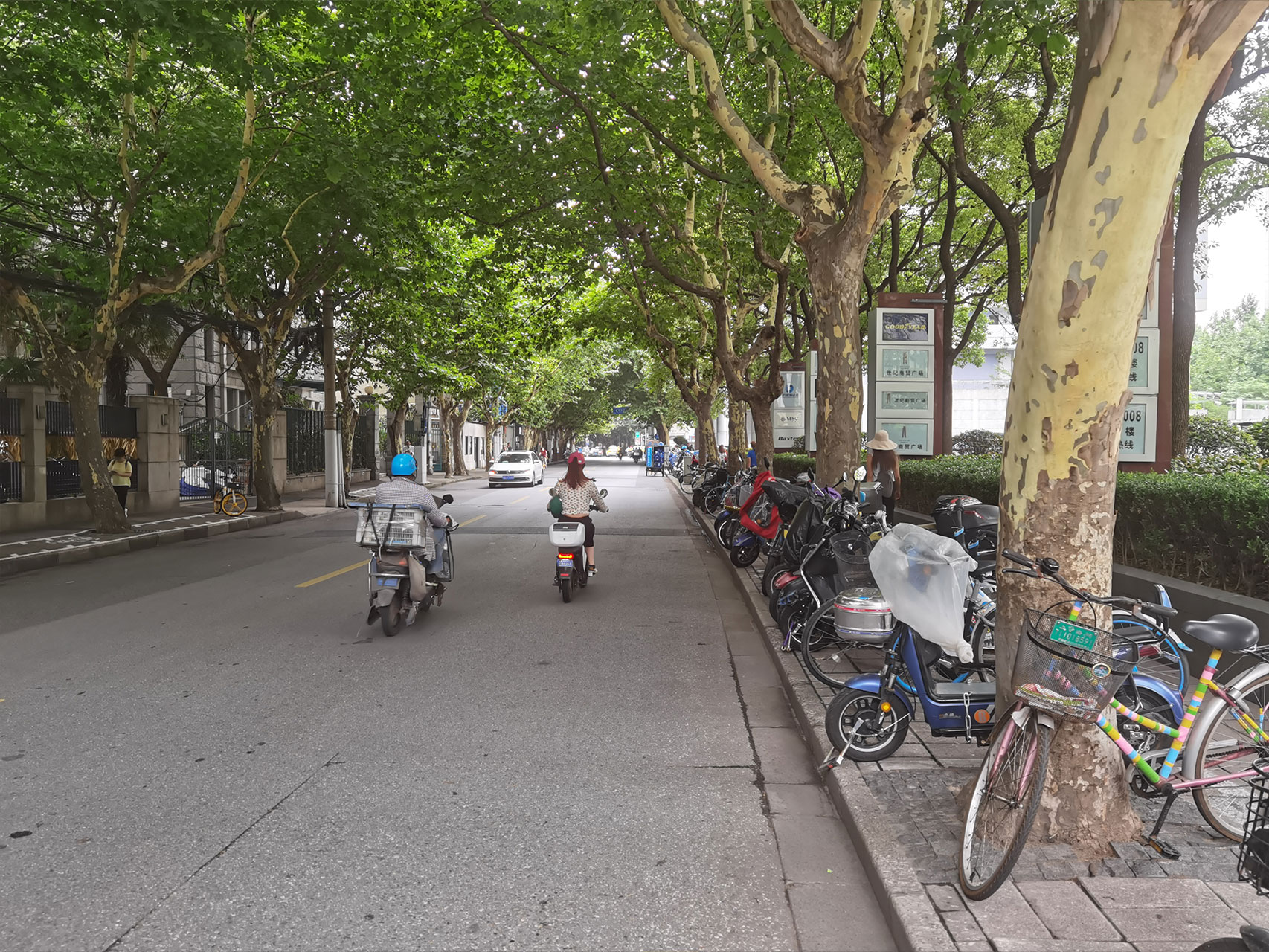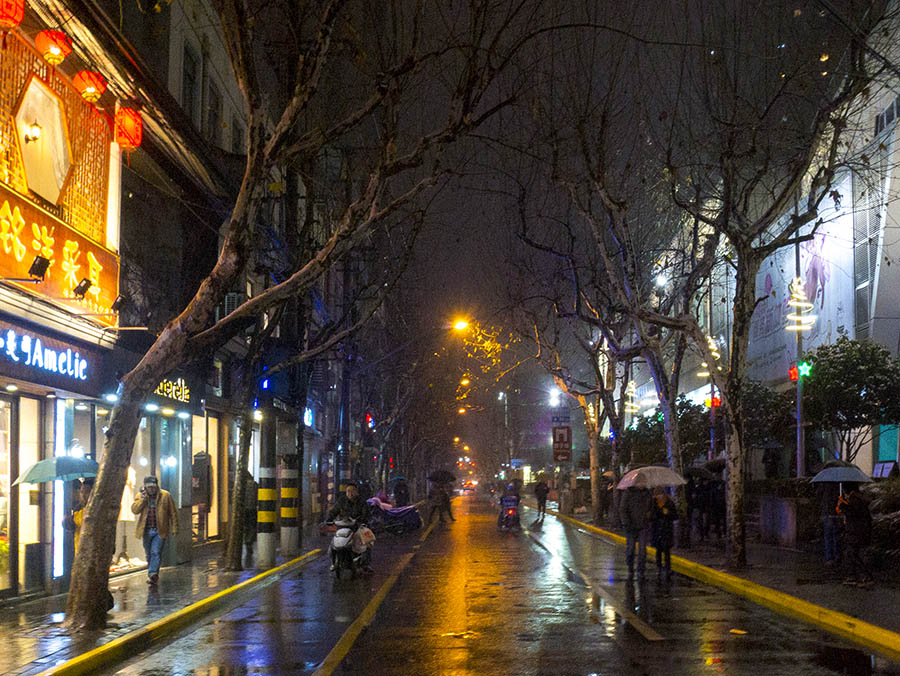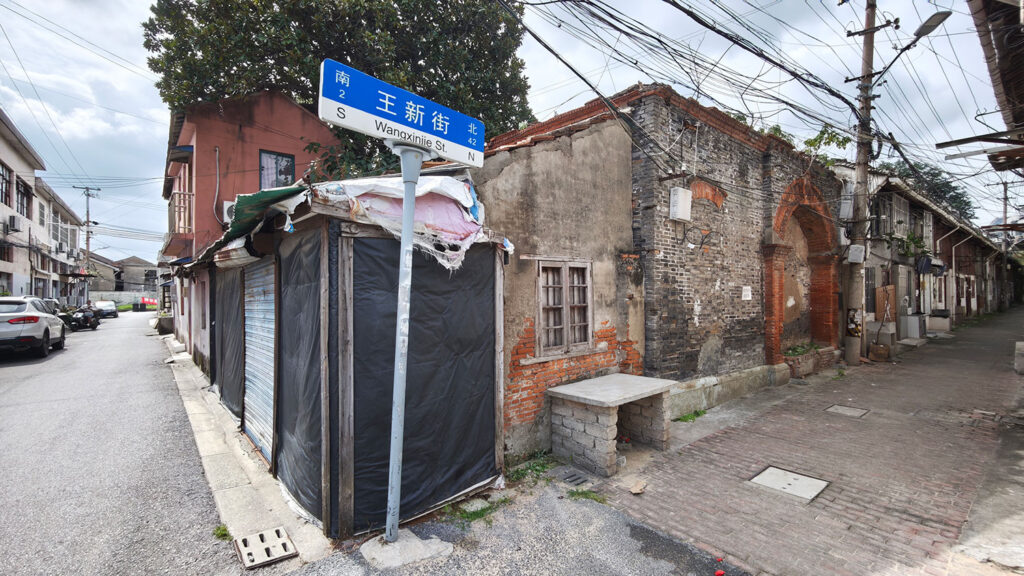
Two out of three trees in Shanghai are London plane trees.
City planners call it a supertree. Its secret is its peculiar camouflage-patterned bark, which peels off in quick succession, allowing the tree to ‘clean’ itself from pollution. As a result, it has a high tolerance to pests and diseases, and captures smog and carbon well. Additionally, it can handle temperatures both high and low. It needs little water — but also survives an abundance of it. It can handle heavy pruning. It grows in most soils, and because it has shallow roots it doesn’t break up roads. Its leafy canopy on top of crooked branches provides shade in hot summers.
The London plane tree is a hybrid between the American sycamore and the Oriental plane. These parent species originate from opposite sides of the globe, the first native to the United States, the second from an area spanning from the Balkans to China. They came together in the seventeenth century, collected as specimens from European voyages around the world. Planted close together in the Vauxhall Gardens in London, they produced their offspring, the London plane tree, which was discovered by John Tradescant, an aristocratic plant collector.

Its use became widespread after the reconstruction of Paris in the nineteenth century. A massive 2.5 billion franc project under the guidance of Georges-Eugène Haussman untangled the mess of the tiny streets of the French capital and sliced the city with wide avenues. Haussmann loved the London plane tree for the way it looked, and consequently lined the fresh boulevards with them at intervals of around six meters. This then became a trend around the world, and even today you’ll find the London plane tree in many cities, most notably in London, Rome, Sydney, New York, and Shanghai, where they are called ‘Faguo Wuton’, or ‘French Phoenix Trees’. And it’s such a prominent tree there, because when the French arrived in the nineteenth century, they brought their tree with them.

It was in the nineteenth century that China fought and lost two wars over trade disputes against France, the United Kingdom and the United States. As a compromise, the reigning Qing dynasty signed several treaties that gave these foreign invaders more freedom, including the right to sell opium, all at the cost of China’s sovereignty. The Qing’s were also forced to give up parts of their territory, such as Hong Kong for the Brits. Germany took Jiaozhou Bay between Beijing and Shanghai. Korea, back then a state of China, was invaded and claimed by the Japanese. And the Portuguese had already founded Macau on Chinese soil in 1557.
Meanwhile, France took areas in the cities of Tianjin, Hankou, and Guangzhou, as well as a small strip of land in Shanghai, in 1849. This was called the French Concession. In 1861 it grew in size, and doubled in size in 1900. The French built many houses in a colonial-era style, dubbed by the locals as ‘Lao Yang Fang’ (‘Old foreign houses’), from lane houses to Normandy cottages. From 1906 to 1910, the St. Ignatius Cathedral was built, making the French Concession one of the centers of Catholicism in China, which it is still today. The area earned its name ‘Paris of the East’, partly due to its flowing streets, lined with wrought iron stair railings and fences (the same material as the Eiffel Tower).
In 1901, a large avenue was built, slicing through the concession from West to East Shanghai as Haussman’s avenues did in the French capital. The street’s first name was Rue Sikiang (西江路) in 1901, but was renamed Route Paul Brunat (寶昌路) in 1906, and Avenue Joffre (霞飞路) in 1915. In 1941, the Japanese invaders named it Taishan Road (泰山路), until they were defeated by the Kuomintang government, who renamed it Lin Sen Road (林森路). That was, until the Communist government took over in 1950, giving it its current name: Huaihai Lu (淮海路).

It was at this road that the London plane tree first took root in Shanghai, in 1902. From there it was planted alongside other lanes in the French area, until in 1928, even the Chinese turned to planting them. In 1928 and 1929, twenty thousand of them were planted in the nearby city of Nanjing, which was then the capital of China, lining Zhongshan Avenue towards the mausoleum of Sun Yat-sen. Many more were planted in the country after the Communists took power in 1949.
In the beginning of the twentieth century, public support for China’s reigning dynasty, the Qing’s, plummeted. The Qing’s had a hugely complicated system of empress-dowagers, eunuchs, concubines, and the emperor himself, and it all proved ineffective in fighting the foreign aggression in China. After conceding rights and territories, underground rebels plotted schemes to overthrow the dynasty — and in 1911, several groups — such as the Tongmenghui, Gelaohui, and Tiandihui — joined forces with the military and warlords, and plunged Peking into a brief civil war. Conceding defeat, Empress Dowager Longyu signed the documents that sealed the abdication of China’s six-year-old emperor, Puyi, in 1912. While Puyi lost power, he did retain his titles and remained as head of the state, but it was only ever going to be an intermediate step of a total abolishment of 2,000 continuous years of imperial rule, which ended in 1924.
A new government party was formed from the Kuomintang movement (which translates into China’s National People’s Party), and in 1912 they formed the Republic of China, with Sun Yat-sen at the helm. Yet the Kuomintang was led by greed, and attempts to monopolize power led to a decade of political unrest and a fractured country, with dozens of regional warlords each claiming a piece of land.
In 1921, the Chinese Communist Party (‘Zhōngguó Gòngchǎn Dǎng’) was founded by students within the French Concession of Shanghai. The Communists grew quickly in numbers, especially among peasants which made up most of China’s population. In 1923, together with the Kuomintang, they formed the First United Front, to battle the warlords and unite China, which succeeded in 1928. But when the two rivals had defeated their common enemy, a new conflict was shimmering.
The Kuomintang was firmly in control of the government, but when its leader, Sun Yat-sen, died in 1925, he was succeeded by Chiang Kai-shek. Chiang was seen as a rightist, to the dismay of left-wing Communist Party. Chiang moved quickly to limit the influence of the communists, and in 1927, he traveled to Shanghai with five thousand soldiers. The communists welcomed Chiang’s arrival, but Chiang turned on them and killed thousands, which is now known as the Shanghai Massacre. In its immediate aftermath, ten thousand of communists were killed by the Kuomintang or its allies throughout the country, signaling the beginning of China’s civil war. The communists, although near destruction, formed the People’s Liberation Army, also known as the Red Army, and with peasant guerrilla forces took patches of rural land to which they fled.
In the nineteen twenties and thirties, Shanghai grew as an economic hub and a bridge from China to the rest of the world, for import and export. Foreign influences appeared on the streets, from fine restaurants to casinos and ballrooms. Much of the played music was a combination of jazz music, which mingled with traditional Chinese folk music. The genre, known as ‘Song of the era’ (shidaiqu) became popular — and as the film industry also boomed, Shanghai became known as ‘Oriental Hollywood’.
All this, while the civil war was ongoing. While Shanghai was strong, it weakened China as a country. Its territory was seemingly up for grabs, which attracted foreign invasion. In 1931, Japan invaded and took the northeastern province of Manchuria, and in 1934 the Soviet Union invaded China from the northwest (although they failed). From Manchuria, the Japanese moved land inwards, and a conflict at the city of Wanping in 1937 escalated into a full-scale war. Japan claimed big chunks of China, including key cities like Beijing, Nanjing and Shanghai, but lacked the manpower to advance deeper into China. Japan was criticized for it internationally — as well as their many atrocities including the Massacre of Nanjing — but opted for political isolation by withdrawing from the League of Nations, the predecessor of the United Nations.
China was governed by the newly formed ‘Reorganised National Government of the Republic of China’, which was, despite its name, a puppet state under the control of the Japanese. Its occupation of China only came to an end after the Second World War. When Japan bombed Pearl Harbor in 1941, the United States turned to China’s defense, and together with Russia and the United Kingdom, the two signed the 1943 Cairo Declaration which demanded for Japan’s surrender and retreat from China. Japan did so, but only after the atomic bombs of Hiroshima and Nagasaki in 1945.
China took its territories back from Japan, with the exception of Korea, which split into two separate countries. And while the Brits kept Hong Kong and the Portuguese kept Macau, the Germans had already ceded Jiaozhou Bay after the First World War, in 1914. The French left Shanghai in 1943. The European country faced a similar situation as China, with part of it being occupied by Nazi Germany, the other part being Vichy France, in reality a puppet state of Germany. Vichy France also held control over France’s colonizes and under pressure from the Japanese, they agreed to hand over its territories in China, including the French Concession. Since neither Vichy France or the Japanese government in China was seen as legitimate, the agreement was ratified again after the Second World War, in 1946, between France and the Kuomintang government of China. As part of the deal, Chinese forces retreated from French Indochina (which is now Vietnam, Cambodia, and Laos).
The departure of nearly all its foreign aggressors ended China’s ‘hundred years of national humiliation’, despite leaving the country war-ravaged and financially drained. But there could be no peace. In 1946, the civil war between the Kuomintang and the Communists reignited. The Communists were helped by the Soviet Union, receiving supplies as well as the captured weapons from the Japanese, while the Kuomintang received air and ground support from the United States.
Mobilizing millions of peasants and led by Mao Zedong, the Communists used a highly fluid strategy, often abandoning newly claimed territory in order to preserve its forces. Instead of holding on to cities, it claimed the surrounding countryside, isolating cities and wearing out the Kuomintang forces — such as the six month siege of Changchun. The momentum swung into the Communists’ favor, who kept growing in numbers. From the north, they drove the Kuomintang who fled to the isle of Taiwan, taking with them the title Republic of China. Mainland China, instead, was established on communism as the People’s Republic of China in 1949.
As a single ruling party, the Communist Party led the country to swift prosperity with its radical reforms, which got China’s agriculture and industry back in production, but it also led the country to a famine that as well as the violent Cultural Revolution movement from 1966 to 1976. It paralyzed China and caused a national trauma. The revolution ended in 1976 when Mao died, and other influentials, ‘The Gang of Four’, were arrested. Deng Xiaoping reformed the country and its economy, reversing many of Mao’s policies and not shying from capitalism and drastic measures such as the one-child policy — both for which he became criticized as well as famed. Deng led China into the frantic growth it is still in today, and his successors as ‘supreme leaders’ have continued most of his policies.
After its chaotic nineteenth and twentieth centuries, China’s progress is insane. For over thirty years, its economy grew by ten percent on average, lifting hundreds of millions from poverty. In 2009 it overtook Germany to become the world’s largest exporter, and in 2030 it is set to become the world’s largest economy. Today’s China is proud, and with hosting the 2008 Olympics in Beijing and the 2010 World Expo in Shanghai, its message to the world is that it has entered the world stage.
Old stereotypes are no longer true, although new ones are also largely wrong. China is both a young and old country. Its state, the People’s Republic of China, was founded only in 1949, but depending on which starting point you take, its civilization is thousands of years old — and while the Romans and Egyptians from that time have vanished, Chinese language, culture and way of thinking remains similar. While European, Middle-Eastern and Indian civilizations had plenty of exchange, the Chinese have developed their own philosophy and sense of aesthetics.
But adding to the blend is Western influence. In the nineties, Western influence gained traction through video games over the internet and bootleg cd’s (dakou) of Western bands such as Nirvana and Metallica. Now, China’s booming middle class has lured many international companies in. Starbucks has two thousand and a half stores — over ten percent of their total stores. Apple sells around fifty million iPhones a year in China, and BMW sells nearly four hundred thousand cars in China — eighteen percent of their worldwide sales. Walk into any cinema and the majority of movies is from Hollywood.
Not just Western luxury goods have infiltrated China. Words — from baby (běibí) to whisky (wēishìjì) — are used, and so too are its values. For centuries, Chinese marriages were contracts between families based on pragmatism. While pragmatism and social class still play key roles, today also love is taken into consideration.
Another factor is urbanization. Rural China revolved around the family in which each member had a clear role, and the overall success of the family was everyone’s aim. Confucianism, which dominates the Chinese school of thought, revolves around relationships, and how we relate to one another. This dynamic was perhaps already changed by the one-child policy. In the seventies, the average Chinese family had almost six children, but since the policy started in 1979, a single child has to carry the pressure of two parents and four grandparents, not just to perform well in school, but also to provide elder care. Rapid urbanization means that each year, fifteen million Chinese move to cities — meaning that now almost sixty percent of the population lives in cities. There, life is more individual, especially since often they leave their families behind in the countryside. Another huge contributor is China’s rising wealth. Instead of surviving through hunger and poverty, China’s youth has the technology and means to show creativity and self-actualisation and presentation — needs higher op Maslow’s pyramid.

As an empire in the nineteenth century, China was no match for the Western industrialization, but in the eighties and nineties, West came to know China as the factory of the world with ‘Made in China’ as something made possible by China’s low manufacturing wages and large-scale industry — something slabbed the back of cheap products like a Happy Meal toy. But in the future, ‘Made in China’ could signal the quality perception we now have with Silicon Valley innovations, German built-quality or Italian design. China is already ahead in many technical areas. Mobile adoption is huge for several reasons, partly because China’s economic rise coincided with the advent of the smartphone in the early twenty-first century. Today, the majority of purchases in China are made through mobile payments, whether it’s scanning at a street food stall or unlocking a shared bicycle.
There’s irony in that China — once having a reputation for being a place for knockoff brands and being devoid of copyrights — is an increasing inspiration for Western companies. Apple Pay is straight out of the WeChat textbook, while Uber is now copying China’s Mobike and Ofo by testing dockless bikes in San Francisco. Meanwhile, Ofo itself is going abroad, and introducing shared bicycles at Cambridge University in England. Mobike is active in Singapore, the United Kingdom, Italy, and the Netherlands. Chinese brands such as Lenovo, Xiaomi, Oppo, Huawei and DJI are opening stores around the world. The whole quality perception of Chinese brands is changing, and the government funding of companies such as BYD Auto and Baidu helps to their further expansion.
There’s growing confidence in China. While its culture is — due to rapid change — partly in a vacuum, it is also gaining traction. Dragons and dynasties remain souvenir shop clichés, but movies like ‘Wolf Warrior 2’ showcase Chinese patriotism through Rambo figures, who at one point in the film hold up Chinese passports as a token of defiance. It’s a sharp turn of a century of victimhood and the legacy of foreign invasions. President Xi Jinping is coaxing the industry from production of export products, to one based on inland-driven production and innovation, transitions countries like Japan and South Korea have also made. Xi’s formulation of the ‘Chinese Dream’ aims for more wealth and a stronger military takes cues from the American dream — although ironically, he is also fighting a war on Western values, such as democracy. China’s governmental model proves highly successful in increasing and maintaining economic growth, although there’s a critique (and an air of superiority) from the West on its lack of human rights and lack of free press.
The reality is more nuanced. China’s Communist Party takes many lessons from Lee Kuan Yew’s model, the founder of post-colonial Singapore, which consists of a strong government with limited political freedoms for its people, yet one that puts the interest of its people first. A demonstration of its effectiveness is simply the increased wealth China went through, in the form of education, infrastructure, health care and jobs — all at a rate incomparable to authoritarian regimes in Africa and the Middle East, or anywhere in the world, for that matter. The democracy in India is far less capable than China in fulfilling the needs of its people.
So in the future, it’s likely that China won’t just export products, but also ideas. While Western countries value transparency and democracy above everything else, they’re often unable to deal with the chaos that it produces. Western politicians have short terms and are held barely accountable for their results, while the same isn’t true in China. What is called corruption is China, is called lobbying in the West. And while the West was hit by the 2008 financial crisis, China’s government proved highly effective fast decision taking, building immense airports and dams, a network of harbours, as well as twenty-five thousand kilometers of high-speed railway lines (and another sixteen thousand in production). China is building in decades what Western countries haven’t managed to achieve in centuries. In 2030, China will have two hundred cities with more than a million citizens.
So far, China’s wealth is located mainly at its east coast, but since the turn of the millennium is investing in the rural parts of the country too, through three massive economic programs, namely ‘China Western Development’, ‘Rise of Central China’ and ‘Revitalise Northeast China’. And to find new ways to export products and services, China is also looking beyond its borders, as over eight hundred Chinese corporations are doing business in Africa, investing in infrastructure, energy, and banking. South America is next, with annual trade now over two-hundred-and-sixty billion dollars.
Another signal of China’s growing influence is that Chinese tourists top international spending, with almost as much as the United States, Germany, and the United Kingdom combined — a feat that is staggering as only five percent of Chinese citizens hold a passport that allows international travel. Many Western airports across the world now have advertisements in Mandarin.
Regardless of its promising future, countless traces of its colonial history still remain. Tsingtao, China’s second-largest brewery, was founded by German settlers in 1903 in the Jiaozhou Bay, as well as Haier who makes fridges and washing machines — while another German immigrant founded the Harbin brewery in 1900 to supply Russians who worked on the Trans-Manchurian Railway. French sneaker brand Feiyue was founded in Shanghai in the nineteen-twenties, and well, Hong Kong has thousands of national companies that were founded by foreigners. The Hong Kong and Shanghai Banking Corporation, for instance, was founded by a Scot.
The French imperialists have left the Shanghai French Concession for over seventy years now, but the area keeps its distinct Parisian look, albeit slightly dented by residential areas that have been demolished, or dwarfed by new skyscrapers and shopping malls. In the nineties, the London plane trees on Huaihai Lu were removed but replaced after public outcry. Nowadays, with Tianzifang as its epicenter, the French Concession is a popular tourist destination — all of which is remarkable for an area that hosted the empire, foreign imperialists, the democratic Kuomintang, the Communists, the Japanese — as well as today’s capitalists and globalists. One of the few constants of Shanghai throughout the last hundred and twenty years has been the London plane tree, an early love child of globalism, with one parent tree — the American sycamore — from the United States, and its other parent — the Oriental plane — originating from Asia.

Written in February 2018, updated with new images in November 2022, and updated again in June 2025.



